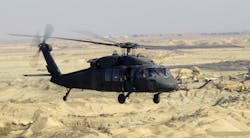Honeywell technology introduces Synthetic Vision Avionics Backbone for enhanced helicopter safety, mission effectiveness
WASHINGTON, 26 Oct. 2013. Honeywell Aerospace (NYSE:HON) finalized testing of a new Synthetic Vision Avionics Backbone (SVAB) designed to enable helicopter operators to integrate multiple types of sensors with Honeywell’s Synthetic Vision System to provide pilots with a 3D view of the outside world in degraded visual environments (DVE).
DVE presents a significant challenge for helicopter operators in both the military and commercial sectors through all phases of flight, but especially during landing and takeoff. A recent Department of Defense report stated that nearly two-thirds of all helicopter accidents can be attributed to loss of situational awareness and the inability to detect obstacles such as power lines and wires.
“This test brings us another step closer to enabling pilots to see in degraded visual environments. It represents a high point in DVE achievement, resulting from several years of ‘backbone’ technology development, combined with our FAA-certified synthetic vision product used in business and general aviation,” explains Howard Wiebold, manager of business development, Honeywell.
“In addition to giving pilots a dramatic tactical advantage when operating in brownout or whiteout conditions, moving this technology forward means increasing operational safety for our warfighters,” Wiebold says. “It increases the number of missions and types of missions commanders can accomplish by simply enabling pilots to fly safely in previously deterred space.
Testing was conducted on a Blackhawk helicopter as part of the Defense Advanced Research Projects Agency (DARPA) Multifunction Radio Frequency (MFRF) program.
“The system accurately detected obstacles, terrain, and power lines, and displayed them in a realistic 3D view on the current cockpit displays. And while this particular test was done on a Blackhawk, the intent is make this sort of technology available for any number of current and future military helicopter platforms, including Future Vertical Lift platforms,” Wiebold says. “The beauty of the SVAB is that it’s ‘sensor impartial,’ allowing any number of sensors to provide input into the common sensor interface. This open approach makes way for an efficient upgrade path, especially while research continues into new and improved sensors for use in DVE conditions.”
“While the U.S. Army CH-47 Chinook and UH-60 Blackhawk appear to be near-term platforms for implementation, the ultimate aim is to give military operators—the broader U.S. Army, Navy, Marine Corps, and Air Force, coupled with NATO allies and commercial operators—flexibility in adopting synthetic vision-based offerings with different sensor packages appropriate to each customer’s needs,” Wiebold adds.
Testing confirmed the ability to register and integrate multiple types of data including real-time millimeter wave sensor with pre-existing precision terrain data into the backbone for a realistic visual rendering of the outside environment, giving pilots the most up-to-date information available, officials say.
About the Author

Courtney Howard
Executive Editor
Courtney, as executive editor, enjoys writing about all things electronics and avionics in PennWell’s burgeoning Aerospace and Defense Group, which encompasses Military & Aerospace Electronics, Avionics Intelligence, the Avionics Europe conference, and much more. She’s also a self-proclaimed social-media maven, mil-aero nerd, and avid avionics geek. Connect with Courtney at [email protected], @coho on Twitter, and on LinkedIn.
